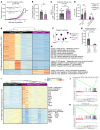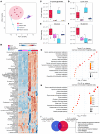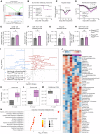AMPK is necessary for Treg functional adaptation to microenvironmental stress during malignancy and viral pneumonia
- PMID: 40100289
- PMCID: PMC12043082
- DOI: 10.1172/JCI179572
AMPK is necessary for Treg functional adaptation to microenvironmental stress during malignancy and viral pneumonia
Abstract
CD4+FOXP3+ Treg cells maintain self tolerance, suppress the immune response to cancer, and protect against tissue injury during acute inflammation. Treg cells require mitochondrial metabolism to function, but how Treg cells adapt their metabolic programs to optimize their function during an immune response occurring in a metabolically stressed microenvironment remains unclear. Here, we tested whether Treg cells require the energy homeostasis-maintaining enzyme AMPK to adapt to metabolically aberrant microenvironments caused by malignancy or lung injury, finding that AMPK is dispensable for Treg cell immune-homeostatic function but is necessary for full Treg cell function in B16 melanoma tumors and during influenza virus pneumonia. AMPK-deficient Treg cells had lower mitochondrial mass and exhibited an impaired ability to maximize aerobic respiration. Mechanistically, we found that AMPK regulates DNA methyltransferase 1 to promote transcriptional programs associated with mitochondrial function in the tumor microenvironment. During viral pneumonia, we found that AMPK sustains metabolic homeostasis and mitochondrial activity. Induction of DNA hypomethylation was sufficient to rescue mitochondrial mass in AMPK-deficient Treg cells, linking AMPK function to mitochondrial metabolism via DNA methylation. These results define AMPK as a determinant of Treg cell adaptation to metabolic stress and offer potential therapeutic targets in cancer and tissue injury.
Keywords: Immunology; Intermediary metabolism; Mitochondria; Oncology; Pulmonology; T cells.
Figures






Update of
-
AMP-activated protein kinase is necessary for Treg cell functional adaptation to microenvironmental stress.bioRxiv [Preprint]. 2023 Dec 1:2023.11.29.568904. doi: 10.1101/2023.11.29.568904. bioRxiv. 2023. Update in: J Clin Invest. 2025 Mar 18;135(9):e179572. doi: 10.1172/JCI179572. PMID: 38076988 Free PMC article. Updated. Preprint.
References
MeSH terms
Substances
Grants and funding
- R01 HL153122/HL/NHLBI NIH HHS/United States
- U19 AI181102/AI/NIAID NIH HHS/United States
- K08 HL159356/HL/NHLBI NIH HHS/United States
- S10 OD011996/OD/NIH HHS/United States
- P01 AG049665/AG/NIA NIH HHS/United States
- U19 AI135964/AI/NIAID NIH HHS/United States
- P30 CA060553/CA/NCI NIH HHS/United States
- P01 HL154998/HL/NHLBI NIH HHS/United States
- T32 AI083216/AI/NIAID NIH HHS/United States
- F31 HL162490/HL/NHLBI NIH HHS/United States
- R01 HL149883/HL/NHLBI NIH HHS/United States
- T32 GM144295/GM/NIGMS NIH HHS/United States
- F32 HL162418/HL/NHLBI NIH HHS/United States
- T32 HL076139/HL/NHLBI NIH HHS/United States
LinkOut - more resources
Full Text Sources
Research Materials

